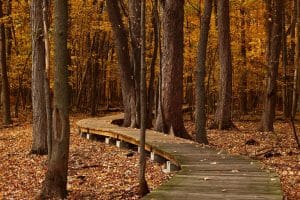Learner-Centered Tip of the Week: Teaching Targets in Authentic Contexts
CompetencyWorks Blog
 This week’s tip comes from Seth Mitchell, a technology integration coach in the Monmouth schools in RSU 2. This post originally appeared at the Learner Centered Practices Blog on September 25, 2017.
This week’s tip comes from Seth Mitchell, a technology integration coach in the Monmouth schools in RSU 2. This post originally appeared at the Learner Centered Practices Blog on September 25, 2017.
Last year, second graders at HLC – ably guided by Brittany Brady, Winona Prince, and Katie Torrington – embarked on a year-long journey to apply their learning in a real-world context. Their combined efforts culminated in learners becoming trail guides and offering guided tours of a local hiking path. As students worked their way along the one-mile trail, they shared their knowledge about the flora and fauna of Whittier Woods, explaining how plants, trees, and various classes of wildlife have adapted to this particular environment. Trail visitors stopped at eight different locations to read student-created informational signs that not only synthesize what the students learned, but also display original, digitally produced artwork. QR codes on the signs provide access to videos featuring student experts, who explain what hikers might see at each location on the trail. It was a proud moment for learners, for the expert educators who guided them through the process, and for the parents who expressed admiration for what these young people have accomplished. The project began the previous school year with some important questions: How can we situate target learning within an authentic context? How can we bundle standards to provide greater relevance for new knowledge? How can we tap the valuable resources of the community as we design learning experiences?
There were several important factors that led to the project’s eventual success:
- Technology was an integral part of the process, but it wasn’t the learning goal. Teachers didn’t start out with tech integration as the driving motivation, but it became a necessary tool in the project’s development.
- Foundational learning served an important end goal. As students steadily developed their understanding of the targets over the course of the year, they continually returned to their ultimate purpose for learning: to educate those who visited Whittier Woods. For example, when students learned about biodiversity (one of their science topics) in general terms, they were then able to focus on the adaptations local hikers could witness firsthand on the trail.
- Bundling targets created opportunities for students to see relationships across content areas. The second-grade team looked at the measurement topics they needed to hit over the course of the year and bundled standards from math, social studies, and science to form the foundation of the unit.
- Teachers crafted a rich learning opportunity by working collaboratively with each other and with the community. In a learner-centered, proficiency-based environment, teachers know they do not need to be the experts in everything. With this in mind, the team invited the help of a state wildlife biologist, two local naturalists, the school’s technology integration coach, and numerous parent volunteers. Having outside experts co-deliver instruction illustrated for students the relevance of the concepts.
- Learners produced work that authentically serves the community. Strong evidence of learning now lives in informational trail signs and videos that will serve our community for years to come. When learners gave guided tours of the trail at the end of the project, they beamed as they shared what they had learned. The knowledge they acquired has purpose beyond an evidence score.
- Teachers embraced the mess. The kind of learning that is most memorable and satisfying rarely fits neatly in boxes. If learners are actively engaged in process and content, all involved—learners, teachers, and administrators—need to be comfortable with controlled chaos as students learn how to learn and as teachers check and adjust. During the Whittier Woods project, a visitor might have entered a classroom and made mental note of the learning environment. The room wasn’t silent. The kids weren’t seated in rows. The teacher wasn’t at the front of the room. Instead, the visitor would have seen teachers moving about the learning space as some students were accessing research on Chromebooks, some were individually handwriting drafts, some were selecting images for informational videos, and still others were composing digital artwork for the signs. The classroom was buzzing with activity while students collaborated with one another and worked through healthy, productive struggle.
While this long-term project definitely required some commitment, it’s possible to take much smaller bites and still adopt the strategies and mindsets listed above. Creating authentic contexts for learning can be challenging, but success is sweet when the details come together.
See also:
- Learner-Centered Tip of the Week: Giving Learners MORE Voice
- Learner-Centered Tip of the Week: Including Multiple Readiness Levels
- Learner-Centered Tip of the Week: A Move to Increase Agency
Seth Mitchell is a technology integration coach in the Monmouth schools in RSU 2. A Southern Maine Writing Project teacher-consultant and former high school English teacher, he enjoys collaborating with other educators to design teaching and learning experiences.